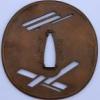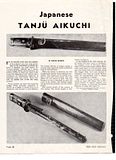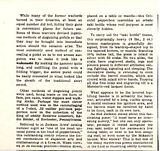-
Posts
828 -
Joined
-
Last visited
-
Days Won
4
Content Type
Profiles
Forums
Events
Store
Downloads
Gallery
Posts posted by Lee Bray
-
-
Shibata has plenty of stock of this book in their store in Tokyo if anyone is heading that way or knows if they do mail order.
Well worth getting and no doubt will spark some interesting debates.
-
-
-
Ideas on?
The first looks like it was a kashira. Correct orientation for the scene.
The second doesn't look like a kashira. Too flat and and the boat would be headed to Davy Jone's locker or skyward if mounted.
The workmanship on that second piece is fabulous.
Their expressions are incredibly detailed given the size.
-
I think I have my answer here. I am not comfortable putting modern repro/practical fittings on my blade and I don't think mounting in edo fittings make sense from a preservation (or financial) perspective. Does't do the fittings the justice they deserve, nor does it 'fit' the gendai blade. I think the real answer here is keep my eyes pealed for original Showa pieces that Mr. Flynn mentioned. Thank you all for the conversation and conjecture.
If the Japanese can dress a fine old Koto blade in Gunto mounts to take to war, I don't think anyone can object to your idea.
As Rich said, it's been done for years and providing you do no damage to all the parts involved, I don't see a problem.
-
I like that first one a lot.
Very delicate and finely controlled rim.
-
Whilst ebay is not set up to protect the uninformed buyer it only makes money if buyers buy from the seller so I don't think ebay is out to swindle anyone.
Anyone remember Mackstar, a 'dealer' on ebay?
I bought from him before his reputation became known and although the deal was fine, he sent the original sword registration card with it(Tokurusho?).
I asked him about this as it meant it wasn't exported through the correct channels and being a novice, I was a little worried.
He replied saying they made a mistake but not to worry, I got the sword. I asked if they could rectify the mistake as I intended to ship it back to Japan for polish.
Next thing I know, my real name and address is posted on all his auctions stating that I'm a bad customer and a trouble maker. Nasty man.

Anyway...point of the story is I complained to ebay and within a day, all his auctions had been pulled.
When he relisted, no mention of my name was made.
I found ebay were fast and responsive with the only complaint I've ever had to lodge with them.
Perhaps the case warranted more of a response than a standard returns case but I was happy with their actions.
-
It doesn't have to end like that if you don't want it to.
The seller has made an offer; you don't have to accept it.
He misrepresented the blade, plain and simple.
His reply of "the condition of the blade is very common for a 400 year old piece" does not excuse that fact.
It has plainly viewable flaws where he stated there were none.
If you wish to keep it, great.
If you wish to return and get your money back, tell him so then contact ebay.
Don't feel bad about the purchase and don't feel obligated to keep it.
-
3 or 4 years back, you'd probably have had to pay twice what you just paid for that piece on ebay.
With today's market, I think you could get a better piece with your money. But not that much better.
Can you learn from it and enjoy it as is?
If you can, keep it.
If not, you have perfectly legitimate grounds for getting a full refund with the sellers misrepresentation of the blade.
It has at least two large ware that I can see in those pics. Seller said it had none. If it were me, I'd send it back unless the blade was doing some serious 'speaking' to me in hand.
-
Otherwise, simply enjoy it for what it is.
Sound advice. It's certainly a lovely piece regardless of origin.
I think you guys are right.
Based on the nanako, I didn't think it was a great piece but seeing the exact same signature on another piece made me think.
-
I have a kodzuka signed Goto Genjo with kao which I'd like to discuss.
It's in shakudo with a partial gold reverse, I think which is mercury gilded(?)
The nanako is hand done and not plate.
I'd like to find out more regarding the artist.
From this thread, viewtopic.php?f=15&t=5366, the same mei is shown and the two compare well in my opinion, so that makes me think it is not gimei, although it's possible both are.
The work on the dragon is well detailed and crisp but the nanako background is, imo, not so great.
From an article in an old journal of the 'To-Ken society of Great Britain', I believe the Goto school used Tatsuta nanako which had three types: horizontal, diagonal and vertical alignment- signifying late, mid and early Goto.
My piece appears to have horizontal alignment, although not precisely perfect, which signifies late Goto.
However, Reinhard says in the thread linked above that Genjo worked in the Keicho period(1596 - 1615) which seems a little early to be late Goto.
As the nanako is not great quality, I'm guessing that Genjo is not a master and either his own nanako technique needed work or that he was provided with a nanako ground to work on that is not great quality, presumably indicating the better nanako ground makers work went to masters, again meaning Genjo was not top ranked.
Although the kodzuka is very good quality in my opinion, I don't think it is Goto master work.
What do you guys think?
-
Sorry to bring this up again.
Peter, did you find any information on this artist and did you get the mei verified?
I have a kodzuka by the same artist with a very similar mei.
viewtopic.php?f=15&t=7867&p=63963#p63963
The quality of the kodzuka is very good.

-
Thanks, Moriyama San.
The third reading looks to be correct and a match with the piece in this thread.
viewtopic.php?f=15&t=5366&start=0&st=0&sk=t&sd=a
Glad I got the first one correct.
Second needs some work...

-
Teru is the third kanji on the first kodzuka?
-
I have two kodzuka and one fuchi mei that I need help with.
The fuchi is, I think, Nara Toshishige.

The first kodzuka, possibly Hiro ? Hidetoshi (dubious).

The second, I have no clue, except maybe Moto for the 3rd kanji.

Thanks.
-
Hi Jim,
Long admired your work and nice to see you here.
-
Thanks, Ludolf. I'll check on that.
As it is signed February, 1607, I think it is probably SUM 4 or gimei.
-
Thanks again, Morita San.
Can anyone help with Sumimiya school information?
My resources(Connoisseurs and the internet) contain nothing on the school.
I can get access to Fujishiro and the Nihonto Taikan, though, just not at my home.
-
Kanazawa Sumimiya Saku - Hawley's SUM 4, 1607.
Looks like the one.
Thanks, Morita San.
-
Thank you, Sir.
No, no more kanji under Saku.
The nakago 'seems' ubu and terminates in kurijiri.
It's dated 1607 but maybe I should check that based on my poor reading of this mei.
-
I read it - Kane ? Yasu Taka Saku.

I have no idea on the 2nd kanji and not sure on the 3rd and 4th.

Thanks for any help.
-
The fault of ebay or the fault of the Government for passing insane weapon laws?
-

This is a scan of the visible core steel on my tanto.
Apologies for the quality. Tricky getting good focus along the full length.
There are two large spots around the hamon, as outlined, and what you see adjacent to the mune.
You can see a 'choji' shape extending above the hadori line on the right hand side. That choji - extending partially to the right, down to the habuchi, following the habuchi all the way to the left then back to the hadori line coming to the choji - is core steel. (hope that makes sense)
It's fairly clear along the mune. Adjacent to the mune is core steel.
It's fairly subtle in hand and certainly not glaringly obvious. The colour change is minor.
Here's a link to a bigger pic if you're interested.
-
Core steel is no more prone to rusting than the surface steel.
Colour wise, carbon content makes a difference to the colour/shade of the steel, hence why you can distinguish hada.
I don't know if less carbon equals darker steel or vice versa.
I have a Bizen tanto from the Muromachi period that has core steel showing on one side from poor polishing.
I shall get some photos posted here in the next day or two.
It's also a reasonable example of, imo, bad hadori polish, though not just because it's hadori.
















Am I dreaming or what??????
in Auctions and Online Sales or Sellers
Posted
If this guy is a dealer he should know that is a NCO sword.
If he doesn't, his business will not last long.
Certainly not if he tries to export it.
As for calling the integrity of the Tokorusho system into doubt, it is either faked papers or a copy of one with similar dimensions.
It certainly calls into question the integrity of the seller though, so thanks for the heads up.